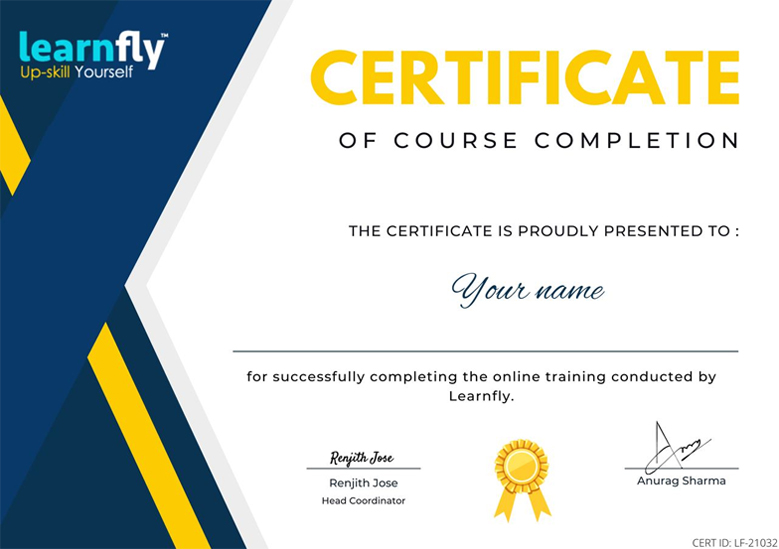It Includes
- 5 Days training program
- Live Virtual Training
- Learn on any PC/Mobile/Tablet
- Unlimited Doubt Sessions
- Online Labs (if applicable)
- Official Courseware & Kits
- Get Recording after session
- Get Certificate of Completion
- Mock Tests & Exam Preps
- Classroom Training (Optional)
Training 2 or more people?
Get a custom quote for group training, Onsite & classroom options.
Request a QuoteCourse Overview
COURSE OBJECTIVE
The ability to create and understand financial models is one of the most valued skills in business and finance today. Microsoft Excel with Visual Basic for Application (VBA) macros programming has been the dominant vehicle used by finance and corporate professionals in the preparation and utilization of the full range of financial models and other applications. However, as a result of the so called ‘95/5’ rule it can be concluded that 95% of Excel users probably only use a mere 5% of the program’s power. Most users know that they could be getting more out of Excel especially by using VBA which would result in them being able to build more flexible, dynamic and professional models. Unfortunately, this aspect of Excel and VBA often appears to be complex and intimidating.
This intensive 5 day workshop starts with basics and progresses in a logical step by step manner to the more complex and rewarding tools needed to build more robust models that save time, reduce unnecessary human errors and customize applications that would be impossible to achieve with suboptimal models. Every section is followed by a direct application related to the financial markets and financial issues.
The course will emphasize some important financial concepts that will assist in building vigorous models. It is designed to give you the information you need without making you wade through cumbersome explanations and endless technical background. Delegates will need some basic knowledge of Excel but not of professional modelling or programming.
Who Should Attend?
- Financial Analysts
- Chief Executive Officers
- Chief Financial Officers
- Portfolio managers
- Corporate accountants
- Credit analysts
- Private equity managers
- Actuarist
- Venture capitalists
- Corporate finance analysts
- Risk managers
- Board members
- Investment bankers
- Regulators
- Financial government officials
- Strategic planners
- Trustees
- Compliance officers
- Management consultants
- Bank lending officers
- Internal auditors
- Management consultants
- Corporate Finance lawyers
Course Outline
-
Design principles for good model building
-
Principle of Occam’s razor
-
Interrelationships within a model
-
Logical arrangement of the parts
-
Setting toggles
-
Model design and structure
-
Attributes of good Excel models
-
-
Exploring Excel functions
-
Financial
-
Date and time
-
Statistical
-
Lookup & reference
-
Database
-
Text
-
Logical
-
Information
-
-
Helpful starting hints
-
Formula errors vs user errors
-
Warning signs
-
Using the F-Keys and combinations of F-Keys.
-
Name ranges using Create Names
-
Making range names more informative
-
Editing name ranges
-
Data validation
-
The Analysis ToolPak
-
Using formula auditing
-
-
The 40 functions you will work with as a financial modeler
-
Basic, intermediate and advanced functions
-
Arguments in advanced functions
-
Dealing with errors
-
Boolean logic
-
Change nested IF’s to something powerful
-
Array formulas
-
Using array formulas with the offset function
-
Calculating geometric return using arrays
-
Annualizing geometric returns
-
The power and manipulation of looking up data
-
Powering the offset with the match function and drop down menus
-
Combining the Index function with the match function
-
Strengthening the If function with (Min, Max, Choose, Offset, And, Or functions)
-
Conditional addition and counting functions
-
Manipulating date functions in complex examples
-
When to use DAYS360 in a model
-
Solving problems with DAYS360
-
Working with parts of numbers
-
Working with numbers in a direction
-
Using the IS-suit (isnumber, istext, isblank, iserror, iserr, islogical, isna, isnontext, isref) with logical formulas
-
Going through a spreadsheet that contains worked examples of all 40 functions
-
-
Financial functions
-
Understanding net present value
-
Understanding internal rate of return
-
Going through a worked example of a project cash flow
-
Problems with the IRR calculation
-
Multiple IRR
-
Shooting yourself in the foot with incorrect assumptions
-
NPV
-
XNPV
-
IRR
-
MIRR
-
XIRR
-
-
Modeling forecasted financial statements
-
Forecasting guidelines
-
Modelling the connection between the income statement and the Balance Sheet
-
Assumptions margin
-
Two ways to balance the balance sheet
-
Using plugs to balance the balance sheet
-
Surplus funds and the necessity to finance
-
Modelling the provision for taxes
-
Static vs dynamic analysis
-
Effect of surplus income from surplus funds
-
Flows in the Cash Flow Statement (Operations, Investment, Financing)
-
Structuring a cash sweep
-
Modelling payment of successive debt tranches
-
Calculation of the post-sweep debt numbers
-
Cash flow variation for cash sweep
-
Reality checks
-
Adding an error trapping formula
-
Using conditional formatting
-
Finding cells that have conditional formats
-
Structuring the input sheet vs output sheets
-
Modelling common size statements
-
Smoothing techniques in forecasting
-
Simple and multiple regression analysis
-
Sensitivity analysis in forecasting
-
-
Modeling Ratio Analysis and Key Performance Indicators
-
Efficiency ratios
-
Profitability ratios
-
Leverage ratios
-
Coverage ratios
-
-
Optimization Solutions with Excel Solver
-
Installing the solver add-in
-
Goal seek
-
Solver parameters
-
Decision variables and constraints
-
Tolerance levels
-
Solving problems with integer constraints
-
Using Solver for a working capital management model
-
Using Solver for a capital budgeting model
-
Using Solver for an inventory policy model
-
Using Solver for a cash management model
-
Using Solver for a capacity planning model
-
-
Pivot Tables
-
Introduction to Pivot tables
-
Creating a Pivot Table report
-
Categorizing raw data
-
The Pivot Table wizard
-
Percentage of column, percentage of raw, and percentage of previous
-
Top and bottom 10 feature
-
Creating formulas in pivot tables
-
Retrieving data from external sources including access and internet
-
Linking Pivot Tables to MySQL
-
Pivot charts manipulation
-
Building one variable Data Tables
-
Building two variables Data Tables
-
-
Power Pivot Extensions
-
Combine data from different sources in one pivot table
-
Combine huge amount of data in the most optimal way
-
Connect to databases
-
Private calculated members
-
Calculations library
-
Limitations
-
View Pivot Table MDX
-
Filtering Pivot Table to a list
-
Changing Pivot Table Defaults
-
Searching in OLAPS
-
Distributing Pivot Tables
-
Best practice
-
-
Monte Carlo Simulation using Crystal Ball:
-
Introduction to Crystal Ball
-
Introduction to probability distributions and their importance in decision making
-
Stochastic vs static models
-
Building a stochastic model
-
Moving away from “Best, Worst and Normal forecasts” to more dynamic solutions
-
Monte Carlo simulation versus “what if” scenarios
-
Incorporating decision rules into Monte Carlo simulations
-
-
Introduction to VBA
-
What is a macro?
-
Creating a simple macro
-
Changing multiple properties at once
-
Assigning a shortcut key to a macro
-
Looking inside a macro
-
Objects, properties and methods
-
Navigating the Visual Basic Auditor
-
Manipulating recorded properties
-
Eliminating repeated objects in a recorded macro
-
The Select…Selection structure
-
The With Selection structure
-
Making long statements more readable
-
Designate a trusted location for macros
-
Looping
-
Branching
-
Automating spreadsheets
-
Retriveing data from non-Excel sources
-
Recording a macro that runs other macros
-
-
Case Study: Automating database update with new month data
-
Task one: automating transfer of data from a non-Excel source
-
Task two: automating data filling
-
Task three: automating column addition
-
Task four: automating data base update
-
Task five: recording a macro that runs other macros
-
Handling pop up messages automatically
-
Simplifying the subroutine statements
-
Finding your ways in VBA even if you are not a programmer
-
-
Loops
-
Creating loops
-
For Each Loop
-
For Loop
-
Do Loop
-
Managing large loops
-
Set a breakpoint
-
Set a temporary breakpoint
-
Show progress in a loop
-
-
Building custom new functions in Excel using VBA
-
Using a custom function from a worksheet
-
Introduction to Project Explorer
-
Adding arguments to a custom function
-
Making a function volatile
-
Making arguments optional
-
Using a custom function from a macro
-
Developing and storing a new add-in
-
Making use of the hundreds of freely available custom functions in the Internet
-
-
Case study: Building a loan amortization table using VBA
-
Coding in VBA
-
Best practice order structure
-
Analyzing the problem and translating it into a macro
-
Explaining the parameters of the table
-
Setting the required calculations
-
Designing the code
-
Testing the code
-
Analyzing potential errors
-
Running the macro in different settings
-
Creating a custom function for the loan amortization table
-
Vendor

Frequently Asked Questions
-
How does Live Training works?
Live training, also known as online training, is a method of delivering training in real-time over the internet. The trainer and the trainees are connected through video conferencing software, allowing for interactive communication and collaboration. During live training, the trainer can present materials, lead discussions, answer questions, and engage with the trainees in real-time. -
Does Learnfly offer Classroom & Onsite training as well?
Yes. We Do! We do offer classroom, onsite, group sessions & 1 on 1 training for selective courses. Contact our support team and our team will assist you with the process. -
Do you provide certification and exam assistance?
Yes! We provide assistance in scheduling & preparing for your exam after a successful training completion. Once you successfully pass your exam, you will be awarded with a certification. -
What if I miss my scheduled class or want to reschedule?
No worries. You can simply request for the next date as per your availability. -
Can I change the trainer if not satisfied?
We only provide highly qualified and certified trainers with 100% satisfaction rate. However, if you are not satisfied with the trainer, you can request for a free replacement. -
Do I get a lab access with the course?
Yes! If your training require a lab access, then it will be included in the price. -
Is Learnfly accredited?
Yes! Learnfly is accredited with many renowned vendors like Microsoft, ISACA, VMWare, PECB, EC Council. Cisco and many more. -
Are Learnfly Instructor's Certified?
Yes. We only provide training via Certified Instructors. -
Where is Learnfly Located?
Learnfly is a global training provider with locations in India, United States, United Kingdom, UAE, Australia & Africa. -
Does Learnfly offer after training support?
Yes. We offer 1 month free support after your training completion for any queries related to your course, examination etc. -
What is Learnfly Platform?
Learnfly Platform is an omnnichannel Learning Management System that allows you to access thousands of self paced courses, attend live classes, track certifications, access interactive quizzes & assignments, Online labs, connect with Instructors & do much more. Join the platform to know more. -
Do you offer a demo live session with an instructor?
Yes! If you need a demo session to get a feel of live training or to evaluate an instructor, then you can request for a 15 minutes free live session. Connect with our training team for more info. -
Can I get a refund if not satisfied?
All of our training comes with 30 days money back guarantee. Refunds are only applicable on instructor training. Exam, labs are non-refundable. -
How can I make a payment for my training?
We accept all major payment methods like debit/credit card, PayPal and Bank Wire transfer. For bank transfer, please contact us at support@learnfly.com -
How can i get started?
Super! Simply click on "Book Now" button on this page to reserve your seat and make a payment. You can choose from available schedules or provide your own. For anything else like quotation, purchase order, bank wire details etc, please contact our training team at support@learnfly.com. See you learning with us soon!
Certification Partners
Meet our official certification partners. Get Certified with internationally recognised names.
Earn International recognition and certification
Earn International recognition and certification
Get Certified : Get Ahead
Get your own personalized Certificate of Completion, once you successfully complete the training with Learnfly. Showcase your certifcation on Linkedin & more.

250k+ Students and growing.
Listen what they say about Learnfly Courses

I enrolled in ECIH course from Learnfly. This platform enabled me to learn difficult concepts with ease and that too at my own pace. I completed the course in a comfortable environment and would surely recommend Learnfly for this IT course that is well in demand.
Helen Thorogood,
- Student -

I enrolled in Machine Learning course from Learnfly. It was a good learning experience and I learnt the concepts well through the video lectures. The videos were well designed and helped me follow a step-by-step approach to complete my course. I recommend Learnfly for this course.
Elanie Mitchell,
- Student -

I was thrilled to pursue Artificial Intelligence course. It is in high demand. I started searching for a good online platform and luckily found Learnfly. I was initially skeptical about it but later found that it was good. My course was completed in a hassle-free manner. Kudos to Learnfly!
Ailsa Thomas,
- Student -

I pursued CEH from Learnfly. I easily understood the stuff as it was imparted in a fresh manner through well-structured video lectures. All the topics were covered in the videos and I could access them as per my requirements at different points of time. I recommend Learnfly platform to save both your time and money.
Pulkit Reddy,
- Student -

There is high demand for Artificial Intelligence course in the job market these days. I chose Learnfly to pursue this course. The video lectures were designed in a learner-friendly way and it was really convenient for me to understand the concepts well in a short span of time invested.
Raghavendran Burman,
- Student -

Machine Learning is a course that is in demand these days. I was not interested to pursue it through classroom lecture mode. I searched for few platforms offering this course online but finally opted for Learnfly. It trained me for the technology and I am now able to gain a better position in my company after learning at my own and attaining the certificate.

 Tech & IT
Tech & IT
 Business
Business
 Coding & Developer
Coding & Developer
 Finance & Accounting
Finance & Accounting
 Academics
Academics
 Office Applications
Office Applications
 Art & Design
Art & Design
 Marketing
Marketing
 Health & Wellness
Health & Wellness
 Sounds & Music
Sounds & Music
 Lifestyle
Lifestyle
 Photography
Photography






























